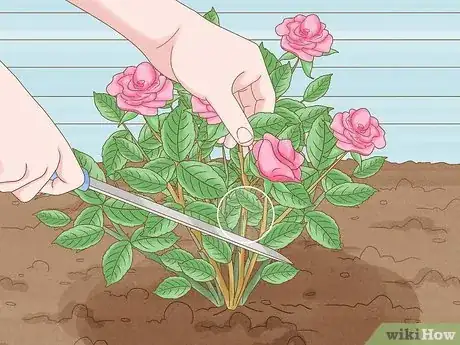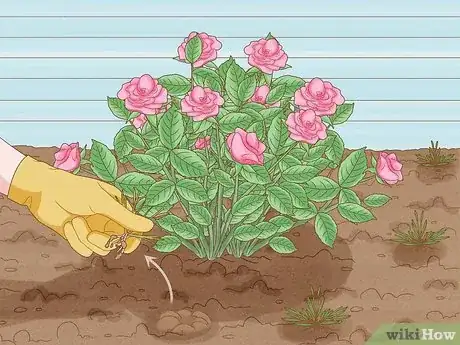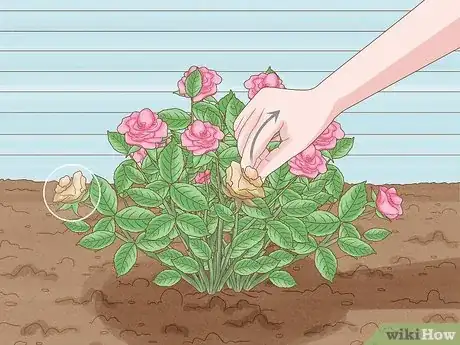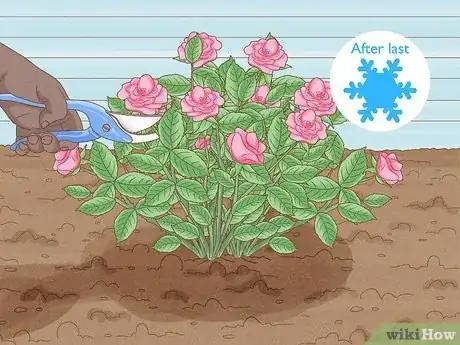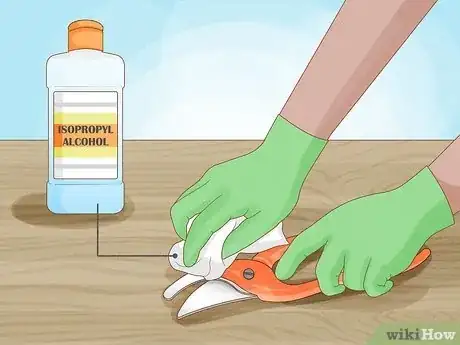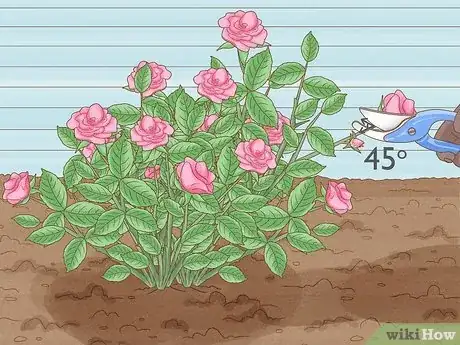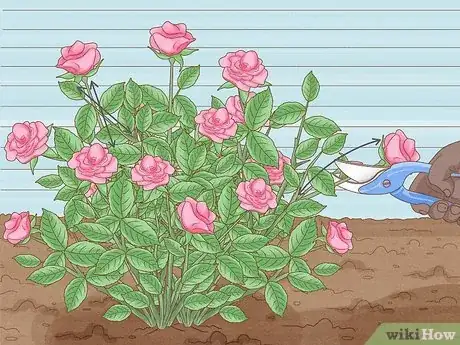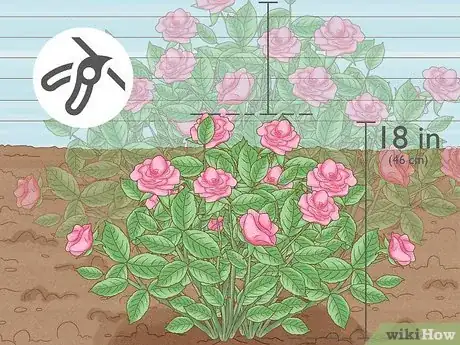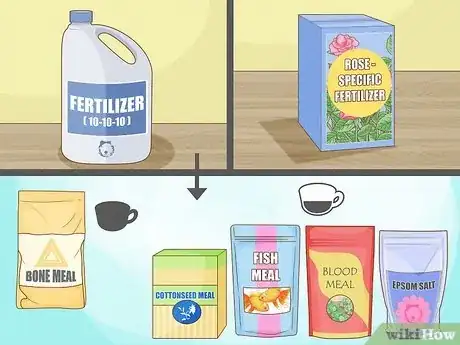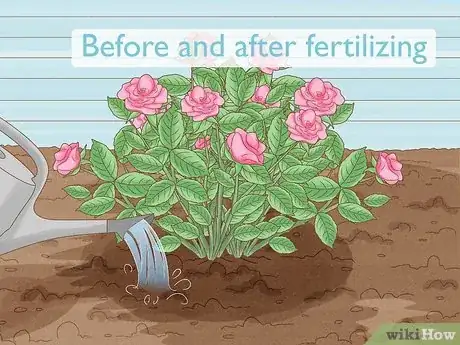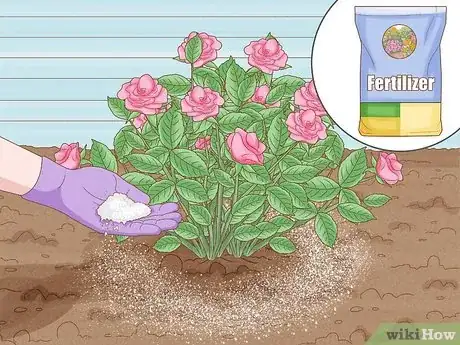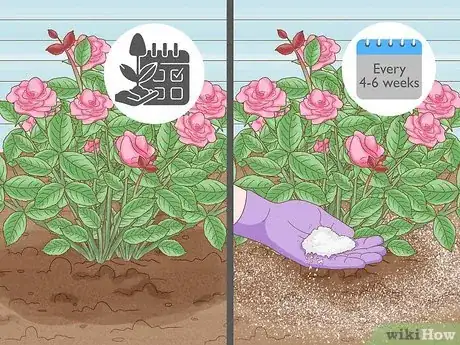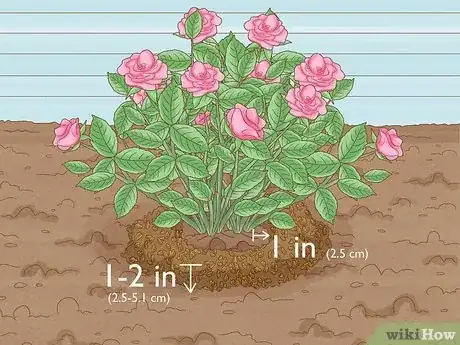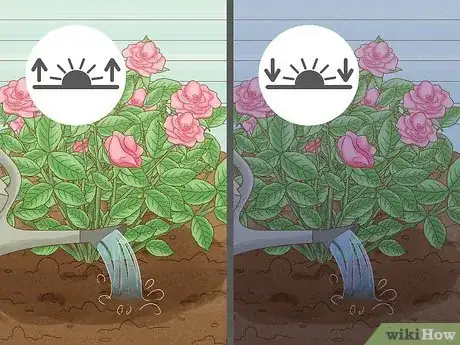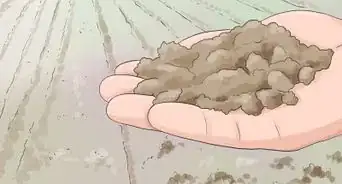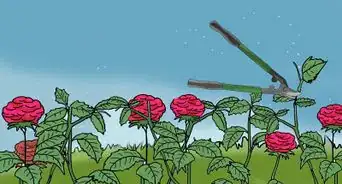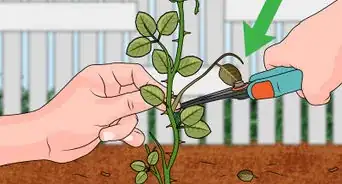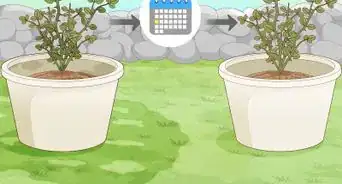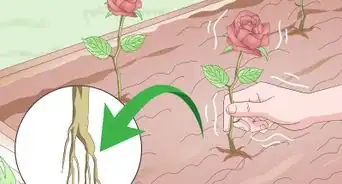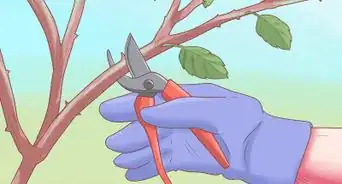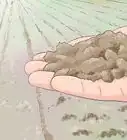This article was co-authored by Lauren Kurtz. Lauren Kurtz is a Naturalist and Horticultural Specialist. Lauren has worked for Aurora, Colorado managing the Water-Wise Garden at Aurora Municipal Center for the Water Conservation Department. She earned a BA in Environmental and Sustainability Studies from Western Michigan University in 2014.
There are 12 references cited in this article, which can be found at the bottom of the page.
wikiHow marks an article as reader-approved once it receives enough positive feedback. In this case, 93% of readers who voted found the article helpful, earning it our reader-approved status.
This article has been viewed 363,150 times.
For avid fans and growers of roses, there is nothing more disheartening than having a rose bush die on you. Before uprooting the little guy and throwing it away, there are steps you can take to revive your rose bush to its former glory as long as it hasn’t completely died. To do this, you’ll need to regularly maintain the area around the roses, prune the bush, water it, and regularly apply fertilizer. If you stay on top of caring for your rose bush, you may be able to save it from completely dying.
Steps
Removing Weeds and Dead Growth
-
1Scrape the bark off a branch to make sure it isn't completely dead. Cut off a branch near the base of your rose bush. Carefully scrape the outside bark on the branch. If there is green under the bark, that means that your rose bush is still alive and you'll be able to revive it. If the branch under the bark is brown, it means your rose bush is dead and you'll have to get a new one.[1]
- Snap a few branches off of your rose bush. If it snaps easily, it is likely that the bush is dead. If the branches are still flexible, it could still be alive.
-
2Clear the area around your rose bush of dead flowers and leaves. Dead flowers and fallen leaves could cause your rose bush to develop diseases. Pick up any dead petals or leaves around the bush by hand and discard or compost it.[2]
- Don’t compost diseased plants since it could spread to other plants.
- Dead flowers and leaves are most likely to appear in the fall.
Advertisement -
3Pull any weeds around your rose bush. Weeds and other plants growing around your rose bush may be sucking up all the nutrients in the soil, thus weakening your rose bush. Pull and remove any weeds that you find in your garden by hand or dig them up with a garden spade.[3]
-
4Pluck dead or diseased flowers off your rose bush. If your flowers or leaves develop spots or splotches of discoloration, it's a sign that they are diseased or dying. Dead flowers and leaves can be plucked off or pruned with hand shears. Neglecting to remove dead or diseased flowers or leaves could spread disease to the rest of the plant.[5]
- Common rose bush diseases include black spot, powdery mildew, and brown canker.
Pruning Your Rose Bush
-
1Prune your rose bush after the last frost. Prune your rose bush as soon as the weather starts to warm up—usually right after the last frost so that your rose bush is not damaged by the cold. During this time, the buds should start to swell.[6]
- You can determine the expected last frost date by using the Old Farmer's Almanac website. Input your zip code into the field at https://www.almanac.com/gardening/frostdates.
- Check the rose bush for signs of new leaf growth and if the buds are starting to grow red in color.
- For most people, this means pruning in the early spring.
- Pruning dead and unnecessary branches will allow the center of your rose bush to grow healthier.
-
2Use sharp, sterilized pruning shears. Rub the shears with ethanol or isopropyl alcohol to sterilize them before you start pruning. Cleaning and sterilizing your rose bush will prevent it from getting diseased.[7]
- Make sure that your shears are sharp or you could cause damage to the bush.
-
3Cut the stems at a 45-degree angle above an outward facing bud. Make your cuts right above an outward facing bud, or a thorn that is facing away from the center of the plant. Avoid cutting in a straight line. Cutting at a 45-degree angle will help the cane heal quicker and prevent water from pooling on the cut.[8]
-
4Cut dead and diseased branches. Cut off the all the dead and diseased looking canes in your rose bush, because it can spread to the rest of your plant. Cut dead or diseased branches down to the crown of the bush. Diseased branches will often have spots or look withered or dying.[9]
- You can tell that a cane is dead or diseased if it has dead leaves and is “woody,” characterized by a dried and brown appearance.
- Dead branches will be brown, rather than green in the center when you cut them.
-
5Prune crossing and outward growing canes. Prune canes that are crossing or branches that are growing outward. Pruning the canes surrounding the center of the plant allows for better exposure to the sun. A healthy, fully grown rose bush typically has 4-7 healthy, vertically growing canes.
-
6Prune the top of the bush so that it’s 18 inches (46 cm) high. Cut off the top portion of growth during the early spring. This will allow your rose bush to grow and bloom new flowers during the new blooming season. Cut off all the branches towards the top of the bush so that the bush itself is only 18 inches (46 cm) high.[10]
Fertilizing Your Rose Bush
-
1Purchase the right kind of fertilizer. Purchase a balanced granular or liquid 10-10-10 fertilizer. This sort of fertilizer will incorporate nutrients back into the soil. The fertilizer should be applied once every 4 weeks during the growing season, or the beginning of spring.[11]
- You can also create your own nutrient powder by mixing together 1 cup (240 ml) of bone meal or superphosphate, 1 cup (240 ml) of cottonseed meal, 1⁄2 cup (120 ml) of blood meal, 1⁄2 cup (120 ml) of fish meal, and 1⁄2 cup (120 ml) of Epsom salt (magnesium sulphate).
- Find a rose-specific fertilizer at your local garden center. They provide exactly the minerals and nutrients that your roses need.
-
2Water the soil before and after laying down the fertilizer. Use a garden hose to water the soil thoroughly before spreading the fertilizer. Watering it before applying fertilizer prevents the fertilizer from burning your plant.[12]
-
3Add fertilizer to the base of the plant, following the label instructions. Lay the fertilizer down evenly around the bush up to the perimeter of your growing area. Keep the fertilizer at the base of the plant, but don’t let it touch its main stalks.[13]
- If the fertilizer is allowed to come into contact with your plant’s leaves, the fertilizer will burn the leaves and cause them to wilt.
-
4Start fertilizing when you notice new growth. Most people fertilize their rose bush at the start of spring; however, if you notice new growth in your rose bush, you can start giving it fertilizer even if it's a bit early. Your rose bush will require more nutrition when it is growing and budding.
- During the peak growing season, fertilize your rose bush every 4-6 weeks.
Mulching and Watering Your Rose Bush
-
1Cover the area around your bush with 1–2 inches (2.5–5.1 cm) of mulch. Purchase an organic or an inorganic mulch online or at a home and gardening store. Sprinkle the mulch around the rose bush in an even layer. Leave 1 inch (2.5 cm) of clearance around the base of the bush.[14]
- Do not pile the mulch up around the crown of the bush.
- Adding mulch will allow the soil to retain more moisture for the roots and discourage weed growth.
- Organic mulch includes wood chips, straw, grass clippings, and leaves.
- Inorganic mulch includes gravel, stones, and glass.
- Replace or add more organic mulch once a year at the beginning of the summer.
-
2Lay down a cardboard mulch if you have weed problems. Laying down cardboard mulch can solve extreme weed problems. Place the mulch over the entire area so that you add a top layer of mulch. This will prevent any weed seeds from being exposed to the sun and will prevent them from sprouting.[15]
-
3Water your rose bush when the soil gets dry. If you don’t have weekly rainfall or your rose bush is a potted indoor plant, you must thoroughly soak the soil. The top 2–3 inches (5.1–7.6 cm) of the soil should be moist. You can check this by poking your finger into the top layer or soil. If it’s dry, water it.
- Roses will wilt and dry out when they aren’t watered enough.
-
4Water your rose bush before sunrise or after sunset. If you water your roses in the middle of the day when the sun is out, they will get water spots. In addition, the water will evaporate quickly and won’t have a chance to penetrate the soil.[16]
Expert Q&A
Did you know you can get expert answers for this article?
Unlock expert answers by supporting wikiHow
-
QuestionCan I add sand to my rose's soil if I don't have a lot of soil to use in the pot?
 Lauren KurtzLauren Kurtz is a Naturalist and Horticultural Specialist. Lauren has worked for Aurora, Colorado managing the Water-Wise Garden at Aurora Municipal Center for the Water Conservation Department. She earned a BA in Environmental and Sustainability Studies from Western Michigan University in 2014.
Lauren KurtzLauren Kurtz is a Naturalist and Horticultural Specialist. Lauren has worked for Aurora, Colorado managing the Water-Wise Garden at Aurora Municipal Center for the Water Conservation Department. She earned a BA in Environmental and Sustainability Studies from Western Michigan University in 2014.
Professional Gardener
-
QuestionHow can I revive wilted rose bushes?
 Lauren KurtzLauren Kurtz is a Naturalist and Horticultural Specialist. Lauren has worked for Aurora, Colorado managing the Water-Wise Garden at Aurora Municipal Center for the Water Conservation Department. She earned a BA in Environmental and Sustainability Studies from Western Michigan University in 2014.
Lauren KurtzLauren Kurtz is a Naturalist and Horticultural Specialist. Lauren has worked for Aurora, Colorado managing the Water-Wise Garden at Aurora Municipal Center for the Water Conservation Department. She earned a BA in Environmental and Sustainability Studies from Western Michigan University in 2014.
Professional Gardener
-
QuestionI bought a rose bush and planted it, but it looks dead. What should I do?
 Community AnswerWait. It will not take long to find out if it is alive or just stressed. Give it liquid plant food immediately, and if you don't see leaves beginning to form in 3-4 days, the plant probably is completely dead.
Community AnswerWait. It will not take long to find out if it is alive or just stressed. Give it liquid plant food immediately, and if you don't see leaves beginning to form in 3-4 days, the plant probably is completely dead.
Things You'll Need
- Gardening shears
- Spade or shovel
- Isopropyl alcohol
- Fertilizer
- Mulch
References
- ↑ https://youtu.be/qRKB5WPLRSY?t=32s
- ↑ http://www.finegardening.com/article/10-ways-to-keep-your-garden-healthy
- ↑ http://www.environment.gov.au/biodiversity/invasive/weeds/weeds/why/impact.html
- ↑ https://www.rodalesorganiclife.com/garden/how-to-mulch-your-garden
- ↑ https://ag.tennessee.edu/EPP/Extension%20Publications/Plant%20Diseases%20Identifying%20Problems%20of%20Garden%20Flowers.pdf
- ↑ https://youtu.be/tsdIkBjCrTI?t=1m13s
- ↑ https://s3.wp.wsu.edu/uploads/sites/403/2015/03/Pruning.pdf
- ↑ https://youtu.be/J6la_YikkQc?t=1m27s
- ↑ https://youtu.be/J6la_YikkQc?t=1m27s
- ↑ https://youtu.be/tsdIkBjCrTI?t=2m18s
- ↑ http://homeguides.sfgate.com/rejuvenate-old-roses-44453.html
- ↑ http://homeguides.sfgate.com/rejuvenate-old-roses-44453.html
- ↑ http://homeguides.sfgate.com/rejuvenate-old-roses-44453.html
- ↑ http://homeguides.sfgate.com/rejuvenate-old-roses-44453.html
- ↑ https://modernfarmer.com/2016/05/sheet-mulching/
- ↑ https://youtu.be/wkmKaLrOBJ8?t=1m8s
About This Article
To save a dying rose bush, clear any weeds or debris from around the plant to prevent disease, and pluck off any dead leaves or flowers. Then, after the last frost, prune off any dead branches by cutting the canes at a 45 degree angle just above a growing bud so the cane heals quickly. You should also apply a 10-10-10 fertilizer every 4 weeks during the growing season to keep the bush well fed, and add 1-2 inches of mulch to help the soil retain moisture and to fight weeds. Keep reading to learn how to use cardboard mulch to fix severe weed problems.
